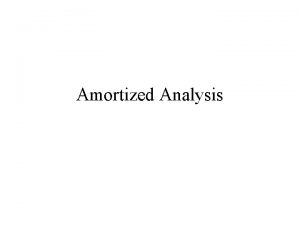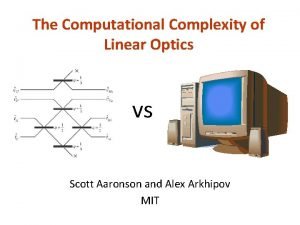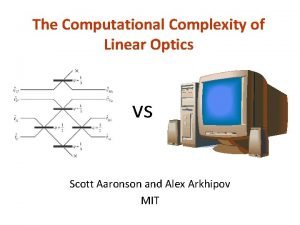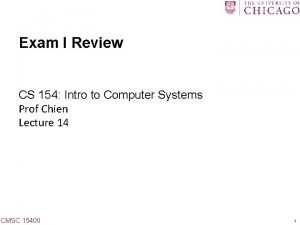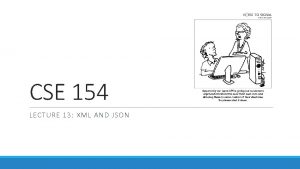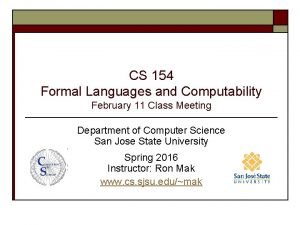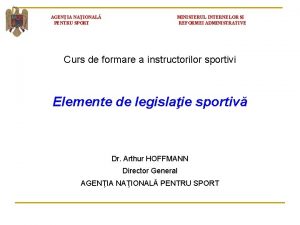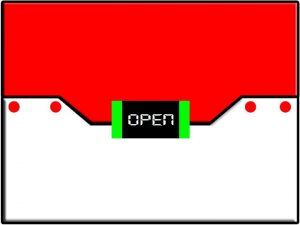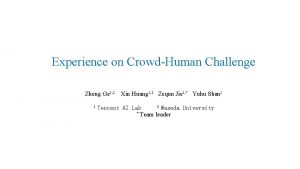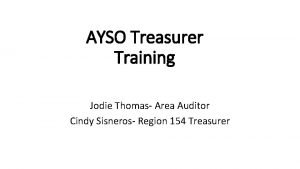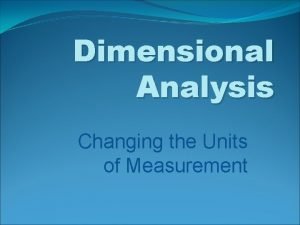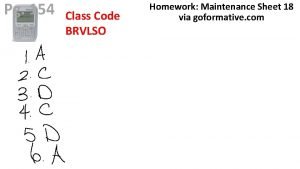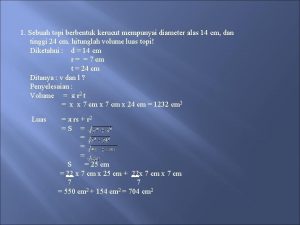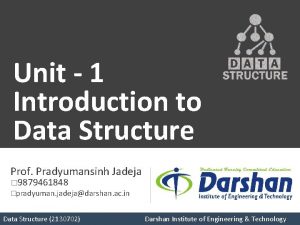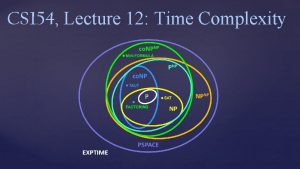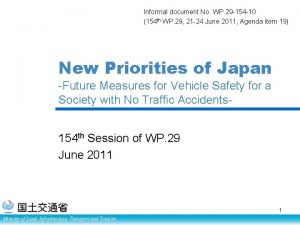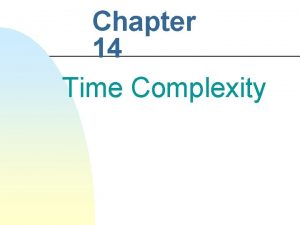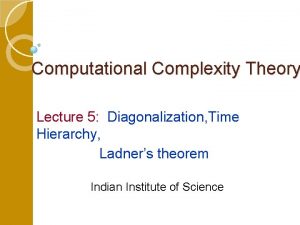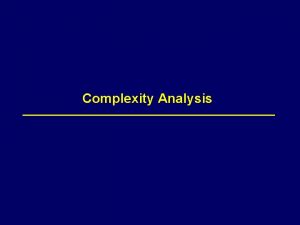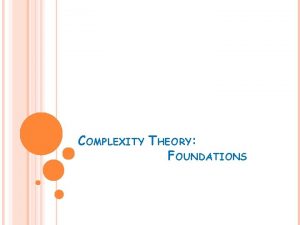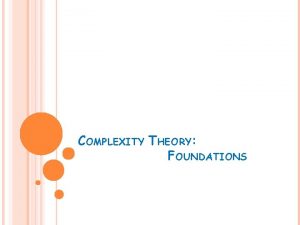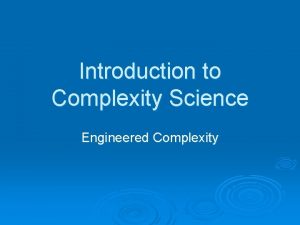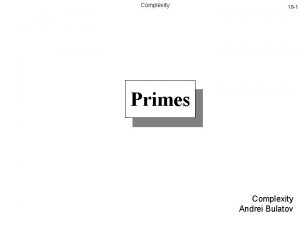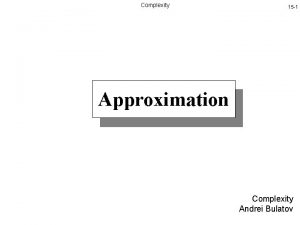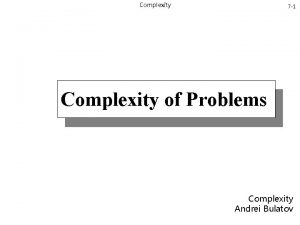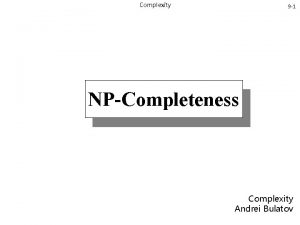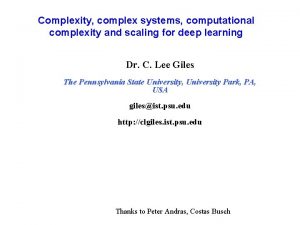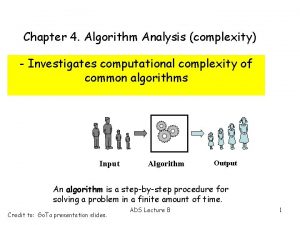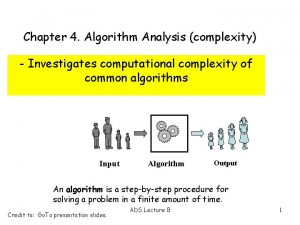CS 154 Lecture 12 Time Complexity Computational Complexity























- Slides: 23

CS 154, Lecture 12: Time Complexity

Computational Complexity Theory What can and can’t be computed with limited resources on computation, such as time, space, randomness, communication, power, … Captures many of the significant issues in practical problem solving. The field is rich with important open questions, many are way beyond our current understanding We’ll start with: Time complexity

Very Quick Review of Big-O Let f and g be functions f, g : ℕ ℕ We say that f(n) = O(g(n)) if there are positive integers c and n 0 so that for every integer n n 0 f(n) c g(n) We say g(n) is an upper bound on f(n) if f(n) = O(g(n)) 5 n 3 + 2 n 2 + 22 n + 6 = O(n 3) If c = 6 and n 0 = 10, then 5 n 3 + 2 n 2 + 22 n + 6 cn 3

2 n 4. 1 + 200283 n 4 + 2 = O(n 4. 1) 3 n log 2 n + 5 n log 2 n = O(n log 2 n) n log 10 n 78 = O(n log 10 n) log 10 n = log 2 n / log 2 10 O(n log 2 n) = O(n log 10 n) = O(n log n) Big-O can help isolate the “dominant” term of a function

Measuring Time Complexity of a TM We measure time complexity by counting the steps taken for a Turing machine to halt Consider the language A = { 0 k 1 k | k 0 } Here’s a TM for A. On input of length n: 1. Scan across the tape and reject if the O(n) string is not of the form 0 i 1 j 2. Repeat the following if both 0 s and 1 s remain on the tape: 2 O(n ) Scan across the tape, crossing off a single 0 and a single 1 3. If 0 s remain after all 1 s have been crossed off, O(n) or vice-versa, reject. Otherwise accept.

Let M be a TM that halts on all inputs. (We will only consider decidable languages now!) Definition: The running time or time complexity of M is the function T : ℕ ℕ such that T(n) = maximum number of steps taken by M over all inputs of length n

Time-Bounded Complexity Classes Definition: TIME(t(n)) = { L’ | there is a Turing machine M with time complexity O(t(n)) so that L’ = L(M) } = { L’ | L’ is a language decided by a Turing machine with O(t(n)) running time } We just showed: A = { 0 k 1 k | k 0 } TIME(n 2)

A = { 0 k 1 k | k 0 } TIME(n log n) M(w) : = If w is not of the form 0*1*, reject. Repeat until all bits of w are crossed out: If (parity of 0’s) (parity of 1’s), reject. Cross out every other 0. Cross out every other 1. Once all bits are crossed out, accept. 00000001111111 x 0 x 0 x 0 xx 1 x 1 x 1 x xxx 0 xxxx 1 xxx 1 x xxxxxxx 0 xxxxxx 1 xxxxxxxxxxxxx

It can be proved that a (one-tape) Turing Machine cannot decide A in less than O(n log n) time! For example, TIME(n log n) contains only regular languages

Two Tapes Can Be More Efficient Theorem: A = { 0 k 1 k | k 0 } can be decided in O(n) time with a two-tape TM. Proof Idea: Scan all 0 s, copy them to the second tape. Scan all 1 s. For each 1 scanned, cross off a 0 from the second tape. Different models of computation can yield different running times for the same language For B = { ww | w {0, 1}*} the gap is quadratic

Theorem: Let t : ℕ ℕ satisfy t(n) n, for all n. Then every t(n) time multi-tape TM has an equivalent O(t(n)2) time one-tape TM Our simulation of multitape TMs by one-tape TMs achieves this! Corollary: Suppose language A can be decided by a multi-tape TM in p(n) steps, for some polynomial p. Then A can be decided by a one-tape TM in q(n) steps, for some polynomial q(n).

Theorem: Let t : ℕ ℕ satisfy t(n) n, for all n. Then every t(n) time multi-tape TM has an equivalent O(t(n)2) time one-tape TM

Theorem: Let t : ℕ ℕ satisfy t(n) n, for all n. Then every t(n) time multi-tape TM has an equivalent O(t(n)2) time one-tape TM

Theorem: Let t : ℕ ℕ satisfy t(n) n, for all n. Then every t(n) time multi-tape TM has an equivalent O(t(n)2) time one-tape TM

Theorem: Let t : ℕ ℕ satisfy t(n) n, for all n. Then every t(n) time multi-tape TM has an equivalent O(t(n)2) time one-tape TM

Theorem: Let t : ℕ ℕ satisfy t(n) n, for all n. Then every t(n) time multi-tape TM has an equivalent O(t(n)2) time one-tape TM t(n) time O(t(n)2)

An Efficient Universal TM Theorem: There is a (one-tape) Turing machine U which takes as input: - the code of an arbitrary TM M - an input string w - and a string of t 1 s, t > |w| such that U(M, w, 1 t) halts in O(|M|2 t 2) steps and U accepts (M, w, 1 t) M accepts w in t steps The Universal TM with a Clock Idea: Make a multi-tape TM U’ that does the above, and runs in O(|M| t) steps

The Time Hierarchy Theorem Intuition: If you get more time to compute, then you can solve strictly more problems. Theorem: For all “reasonable” f, g : ℕ ℕ where for all n, g(n) > n 2 f(n)2 , TIME(f(n)) ⊊ TIME(g(n)) Proof Idea: Diagonalization with a clock. Make a TM N that on input M, simulates the TM M on input M for f(|M|) steps, then flips the answer. Then, L(N) cannot have time complexity f(n)

The Time Hierarchy Theorem: For all “reasonable” f, g : ℕ ℕ where for all n, g(n) > n 2 f(n)2 , TIME(f(n)) ⊊ TIME(g(n)) Proof Sketch: Define a TM N as follows: N(M) = Compute t = f(|M|). Run U(M, M, 1 t) and output the opposite answer. Claim: L(N) does not have time complexity f(n). Proof: Assume N’ runs in time f(n), and L(N’) = L(N). By assumption, N’(N’) runs in f(|N’|) time and outputs the opposite answer of U(N’, 1 f(|N’|)) But by definition, U(N’, 1 f(|N’|)) accepts N’(N’) accepts in f(|N’|) steps. This is a contradiction

The Time Hierarchy Theorem: For all “reasonable” f, g : ℕ ℕ where for all n, g(n) > n 2 f(n)2 , TIME(f(n)) ⊊ TIME(g(n)) Proof Sketch: Define a TM N as follows: N(M) = Compute t = f(|M|), Run U(M, M, 1 t) and output the opposite answer. So, L(N) does not have time complexity f(n). What do we need in order for N to run in O(g(n)) time? 1. Compute f(|M|) in O(g(|M|)) time [“reasonable”] 2. Simulate U(M, M, 1 t) in O(g(|M|)) time Recall: U(M, w, 1 t) halts in O(|M|2 t 2) steps Set g(n) so that g(|M|) > |M|2 f(|M|)2 for all n. QED Remark: Time hierarchy also holds for multitape TMs

A Better Time Hierarchy Theorem: For “reasonable” f, g where g(n) > f(n) log 2 f(n), TIME(f(n)) ⊊ TIME(g(n)) Corollary: TIME(n) ⊊ TIME(n 2) ⊊ TIME(n 3) ⊊ … There is an infinite hierarchy of increasingly more time-consuming problems Question: Are there important everyday problems that are high up in this time hierarchy? A natural problem that needs exactly n 10 time?

Polynomial Time P= k TIME(n ) k N

The EXTENDED Church-Turing Thesis (variant) Everyone’s Intuitive Notion of Efficient Algorithms Polynomial-Time Turing Machines More generally: TM can simulate every “reasonable” model of computation with only polynomial increase in time A controversial thesis! Potential counterexamples: quantum algorithms
 Time space complexity
Time space complexity Amortized complexity examples
Amortized complexity examples The computational complexity of linear optics
The computational complexity of linear optics The computational complexity of linear optics
The computational complexity of linear optics 01:640:244 lecture notes - lecture 15: plat, idah, farad
01:640:244 lecture notes - lecture 15: plat, idah, farad Data system
Data system Cs 154 uchicago
Cs 154 uchicago Cse 154
Cse 154 Cse 154
Cse 154 Cs 154 sjsu
Cs 154 sjsu Al baqarah 154-157
Al baqarah 154-157 Ordinul 154 din 2004
Ordinul 154 din 2004 Dodo akan memberi kado ulang tahun buat desi
Dodo akan memberi kado ulang tahun buat desi Crowdhuman
Crowdhuman Cr part 154
Cr part 154 Ayso nap online
Ayso nap online Dimensional analysis steps
Dimensional analysis steps Inst154
Inst154 Inst154
Inst154 Homework 154
Homework 154 Cs 154 stanford
Cs 154 stanford Sebuah kerucut mempunyai diameter 20
Sebuah kerucut mempunyai diameter 20 Elapsed time
Elapsed time Data structures unit 1
Data structures unit 1

